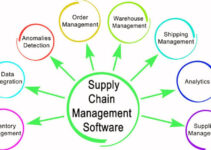Walmart is a retail chain American multinational company. Bud Walton and Sam Walton founded the retail chain brand in 1962; the company has established a network of approximately over 11300 stores in 28 countries across the globe. The company has earned a global reputation for providing top-quality products at the low price. The retail brand maintains the low price due to implementing efficient supply chain practices. Today, we’ll discuss the supply chain analysis of Walmart; it focuses on various SCM elements like procurement planning, inventory management, warehousing, automation, transportation, and distribution.
Supply Chain Analysis of Walmart
Let’s discuss the main elements of the supply chain analysis of Walmart are as follows;
Outsourcing Production & Manufacturing
Walmart removes all the middlemen and 3rd party intermediaries by directly buying the products and goods from the manufacturing partners. The retail chain brand invests a significant amount of capital resources in building a relationship with manufacturers to gain a clear insight into the production cost and how they could reduce the price and cost to the lowest level. In short, the retail company focuses on partnering up with the right production suppliers at the least possible price.
Distribution Centers
The logistics and distribution of Walmart comprised shipping products and goods from the manufacturing factories to the distribution centers. They keep moving the products and goods at the retail chain stores within 24 hours a day; the distribution centers only deal with small shipments of the products.
Walmart has a network of consolidation centers for dealing with and managing the large volume of products and goods. The retail chain brand has established a network of approximately 210 distribution centers; and 6 disaster distribution centers to respond to the needs and demands of customers in case of emergency.
Walmart implements the omnichannel distribution strategy; it consists of selling products to the retail chain stores and e-commerce. The stores and fulfillment centers deliver products to the end consumers.
Outsourcing Warehousing & Inventory Management
Walmart outsources its inventory and warehousing operation to the vendors and they call it vendor-managed inventory (VMI). It is obligatory for vendors to manage the inventory. VMI amplifies the replenishment stores and decreases the unexpected errors, and inventory cost for the company as they don’t manage the inventory.
However, Walmart deals with four types of inventory; they’re as follows;
- Finished Good Inventory: delivering frequently replenishable goods to the stores
- Transit Inventory: deals with such products that take a lot of time to reach the stores
- Buffer Inventory: manages the unexpected increase in demand for the particular products
- Anticipation Inventory: seasonal fluctuation in demand
Cross Docking
Walmart employs a docking strategic approach and solution for transferring products and goods from the inbound trucks to the outbound trucks without involving any intermediary. They deliver products and goods to the retail chain stores from the distribution centers. However, some of the main benefits of cross-docking at Walmart are as follows;
- Decreases the inventory size
- Limited storage of products and goods in the warehouse
- Reduces expired product waste
- Speed up the process of delivering products to the retail stores
The effectiveness of the cross-docking solution is dependent on the communication between the point-of-sale system, distribution centers, and the vendor. Walmart should employ the satellite network to speed up the communication between the vendor and POS.
Transportation
Walmart employs a private fleet of trucks and skilled drivers to move products and goods from the distribution centers to the shelves of the store. The logistics unit focuses on finding the most efficient route for the drivers to save time and it manages the overall shipping process. However, drivers would consume limited fuel by driving less, and it decreases the carbon footprint.
Automation Technology
Walmart implements the latest automation technology to manage its various supply chain processes. For instance, the retail chain brand employed the VOS (voice-based order-filling system) in its retail chain stores to facilitate the order-picking process and method. The company employs the online EDI system for speedy communication between the stores and the suppliers; it helps them in stocking the shelves.
The retail chain brand Walmart has successfully moved from bar-code scanning technology to RFID (radio frequency identification) technology to achieve speed and efficiency. The RFID technology has benefited the company in multiple ways;
- Decreasing the supply chain operational and processing cost
- Improves the overall productivity of labor
- Removes the need to physically scanning the products and goods
Relationship with Suppliers and Vendors
Walmart has established a very good and effective relationship with manufacturing partners and suppliers. It helped the company to ensure the smooth availability of products and goods and finish on time without any delays at the possible lowest price.
Conclusion: Walmart Supply Chain Analysis | Walmart Supply Chain Management
After an in-depth study of the supply chain analysis of Walmart; we have realized that Walmart is the world’s leading retail chain brand. If you are learning about the Walmart supply chain analysis; then you should keep in mind the abovementioned SCM elements; procurement, planning, transportation, automation, inventory management, and sortation.
Ahsan is an accomplished researcher and has a deep insight in worldly life affairs. He goes Live 3 days a week on various social media platforms. Other than research writing, he’s a very interesting person.


